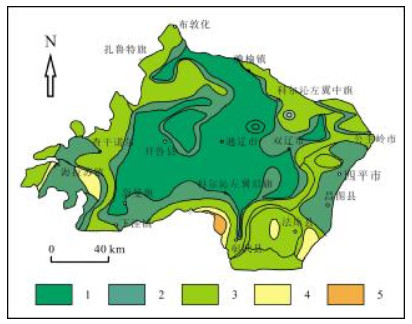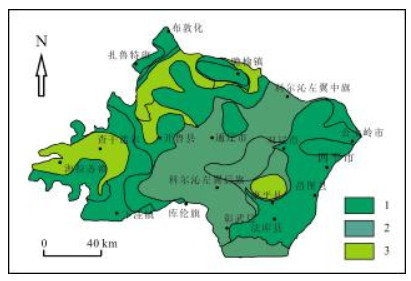地下水中的“三氮”即硝酸盐氮(NO3--N)、氨氮(NH4+-N)、亚硝酸盐氮(NO2--N),其污染被作为农业活动与生活污染的主要特征 [1]. 随着人口增加、城市化发展、工业废水的大量排放以及农业氮肥的过量施用,地下水中“三氮”污染问题愈加严重 [1-2]. 研究发现,“三氮”中的硝态氮和亚硝态氮对人、畜的危害比较大,饮用富含亚硝态氮的水能够导致人体内变性血红蛋白增高,使其丧失输氧能力,甚至致人死亡 [3-4];人体内硝酸盐和亚硝酸盐还能够在各种含氮有机化合物作用下,形成稳定的、致癌和致突变性的亚硝基胺的各种亚硝基族化合物,对人体健康造成危害.
目前,国内外地下水中“三氮”污染的研究主要集中于“三氮”的迁移转化 [5-9]、“三氮”的污染特征及分布 [10-12]、“三氮”污染来源及影响因素 [13-16]、“三氮”的风险评价 [17-18]及“三氮”的污染治理 [19-20]. “三氮”的健康风险评价由于与人体健康直接相关,目前越来越多的专家学者关注于对我国不同地区地下水中“三氮”的健康风险研究,以期为“三氮”的污染防治提供科学的指导 [21]. 葛婷婷等 [17]讨论了新疆和田地区地下水“三氮”污染特征并对不同人群的健康风险进行了评价;李天宇 [22]采用EPA健康风险模型对大安灌区农业活动影响下的地下水中硝酸盐氮及氨氮进行了健康风险评价,并划分了高风险地区及低风险地区;马海珍等 [18]基于梯形模糊理论构建了地下水环境健康风险模糊评价模型,评价了保定某水源地的地下水中氨氮及重金属的健康风险. 西辽河平原作为东北重要的农业生产基地,地下水中“三氮”污染分布特征及健康风险评价未见报道.
本文通过气相分子吸收光谱法 [23]测定西辽河平原浅层地下水中“三氮”含量,探究“三氮”的分布特征及污染特征,采用EPA健康风险模型对地下水中“三氮”进行健康风险评价,以期为进一步讨论“三氮”的污染来源,进而对地下水资源保护和污染防治提供参考.
1 实验部分 1.1 样品采集与分析地下水样品采集根据GPS坐标定位,在西辽河平原中部、南部、北部、东南部、西南部5个区域,每个区域采集水样20个,共采集100个水样. 地下水样品的采集及保存按照《地下水环境监测技术规范》(HJ/T 164-2004)及《地下水质检验方法水样的采集和保存》(DZ/T 0064.2-1993)规定. 分别采用《水质氨氮的测定气相分子吸收光谱法》(HJ/T 195-2005)、《水质亚硝酸盐氮的测定气相分子吸收光谱法》 (HJ/T 197-2005)、《地下水质检验方法离子色谱法测定氯离子、氟离子、溴离子、硝酸根和硫酸根》(DZ/T 0064.51-1993)测定地下水中氨氮、亚硝酸盐氮及硝酸盐氮.
1.2 仪器与主要试剂仪器采用气相分子吸收光谱仪(型号GMA 3376,上海北裕分析仪器股份有限公司)和离子色谱仪(型号ICS-3000,美国Dionex公司).
试剂采用亚硝酸钠基准物(优级纯)、硝酸钠基准物(优级纯)、氢氧化钠、溴酸盐、柠檬酸、浓盐酸、无水乙醇、无氨去离子水等. 以上试剂无特殊说明时,均为分析纯,购自国药集团化学试剂有限公司.
亚硝酸盐氮标准贮备液(0.500 mg/mL):称取在105~110 ℃干燥4 h的纯亚硝酸钠(NaNO2) 2.463 g溶解于水,移入1 000 mL容量瓶中,加水稀释至标线,摇匀.
硝酸盐氮标准贮备液(1.00 mg/mL):称取预先在105~110 ℃干燥2 h的优级纯硝酸钠(NaNO3) 3.034 g,溶解于水,移入500 mL容量瓶中,加水稀释至标线,摇匀.
2 评价方法 2.1 污染特征评价内梅罗综合污染指数法广泛应用于水环境评价领域 [24],能够反映整个研究区“三氮”的综合污染状况. 根据所选水质指标的实测浓度和标准值,分别计算内梅罗污染指数和标准指数,与相应的等级标准指数相对照,即可得到评价等级. 计算公式如下:
| $ F=\sqrt{\frac{\bar{F}^2+{F_{\max }}^2}{2}} $ | (1) |
式中:F-各单项组分评分值Fi的平均值,无量纲;Fmax-单项组分评价分值F中的最大值,无量纲.
|
|
表 1 内梅罗综合污染指数分级标准 Table 1 Nemerow criteria of comprehensive pollution index |
地下水中“三氮”健康风险评价采用美国环保局(U.S. EPA)提供的健康风险评价模型和标准,评价内容包括危害识别、剂量-效应分析、暴露评价及风险表征4个部分 [22]. EPA综合风险信息系统(IRIS)中,硝酸盐氮、亚硝酸盐氮、氨氮均属非致癌物 [26]. 本研究仅对地下水中“三氮”进行非致癌健康风险评价. 研究表明 [27],地下水中物质进入人体的途径主要包括饮水和洗浴两种途径. 硝态氮作为躯体毒物质,皮肤接触等其他摄入途径的资料欠缺 [28],故本文仅考虑经口饮水途径暴露对人体产生的健康效应. 评价采用非致癌评价风险模型,非致癌经口参考剂量(RfD)取值 [18]:氨氮0.97×10-6/d、亚硝酸盐氮0.1×10-6/d、硝酸盐氮1.6×10-6/d.
模型非致癌评价风险指数(HI)的计算公式 [29]如下:
| $ \mathrm{HI}=\sum \mathrm{CDI} / \mathrm{RfD} $ | (2) |
式中:CDI-某种有机污染物在某种暴露途径下,有机污染物长期日摄入剂量,10-6/d;RfD-某种有机污染物在某种暴露途径下的非致癌参考剂量,10-6/d.
经口饮水暴露途径的单位体重日平均暴露剂量的计算公式 [22]如下:
| $ \mathrm{CDI}=\frac{\mathrm{C} \times \mathrm{IR} \times \mathrm{EF} \times \mathrm{ED}}{\mathrm{BW} \times \mathrm{AT}} $ | (3) |
式中:C-目标物质的质量浓度,mg/L;EF-暴露频率,通常取值为365 d/a;IR-每日饮水量 [30],成年男性2 L/d,成年女性1.71 L/d,儿童1.0 L/d,老人(60~79岁) 1.74 L/d;ED-饮水持续时间,表示人体终生摄入非致癌慢性毒害物的年数,取30a [31];BW-不同类型人体体重,成年男性65 kg,成年女性56.8 kg,儿童26.8 kg [30],老人(60~79岁) 60.48 kg [32];AT-暴露发生的平均时间,成人取值10 950 d,儿童4 380 d [33].
3 结果与讨论 3.1 “三氮”的检出情况西辽河平原浅层地下水100个样品的“三氮”检出情况见表 2.
|
|
表 2 西辽河平原浅层地下水中“三氮”的检出情况 Table 2 Detection of nitrogen in the shallow groundwater of West Liaohe River Plain |
从表 2可知,研究区100个样品中,“三氮”的最大检出浓度依次为硝酸盐氮(49.1 mg/L)>氨氮(1.95 mg/L)>亚硝酸盐氮浓度(0.915 mg/L),与《地下水质量标准》(GB/T 14848-2017)中Ⅲ类水标准限值对比,“三氮”超标率依次为氨氮(10%)>硝酸盐氮(8%),亚硝酸盐氮无超标点. 与文献[34]对比,硝酸盐氮及亚硝酸盐氮的最大检出浓度低于宁东煤炭基地梅花井矿区地下水中对应含量(234 mg/L、2.01 mg/L),氨氮则相反. 与2014年东北地区松花江吉林段沿岸浅层地下水硝态氮含量超过地下水质量Ⅲ类水标准(20 mg/L)的面积占研究区面积(62.07%) [35]相对比,硝酸盐氮超标面积则大幅度降低.
3.2 “三氮”的污染评价结果内梅罗综合污染指数法不仅能够得出单个测试项目的污染指数,而且能够得到整个流域采样点不同“三氮”测试结果的综合污染指数,从而反映整个研究区“三氮”的综合污染状况 [36]. 通过计算内梅罗综合污染指数,研究区浅层地下水的污染程度分为5级,结果见表 3.
|
|
表 3 研究区地下水水质评价结果 Table 3 Evaluation results of groundwater quality in the study area |
从水质评价结果(表 3)来看,西辽河平原100个浅层地下水样品中,较重污染以上(Ⅳ、Ⅴ级)的井数占17%,Ⅰ-Ⅲ级水占83%,表明研究区浅层地下水中“三氮”污染程度相对较轻.
3.3 “三氮”分布特征西辽河平原浅层地下水中“三氮”的空间分布特征因氮素类别的不同而存在较大的不同,如图 1-3所示.

|
图 1 西辽河平原浅层地下水氨氮浓度分布图 Fig.1 Distribution map of ammonia nitrogen concentration in shallow groundwater, West Liaohe River Plain 氨氮浓度(ammonia nitrogen concentration):1-≤0.02 mg/L;2-0.02~0.1 mg/L;3-0.1~0.5 mg/L;4-0.5~1.5 mg/L;5-≥1.5 mg/L |

|
图 2 西辽河平原浅层地下水硝酸盐氮浓度分布图 Fig.2 Distribution map of nitrate nitrogen concentration in shallow groundwater, West Liaohe River Plain 硝酸盐氮浓度(nitrate nitrogen concentration):1-≤2.0 mg/L;2-2.0~5.0 mg/L;3-5.0~20 mg/L;4-20.0~30.0 mg/L;5-≥30.0 mg/L |

|
图 3 西辽河平原浅层地下水亚硝酸盐氮浓度分布图 Fig.3 Distribution map of nitrite nitrogen concentration in shallow groundwater, West Liaohe River Plain 亚硝酸盐氮浓度(nitrite nitrogen concentration):1-≤0.01 mg/L;2-0.01~0.1 mg/L;3-0.1~1.0 mg/L |
从氨氮空间分布图(图 1)中可以看出,总体区域100个采样点中,氨氮空间分布整体上呈现出西南部低而东北部高的规律,其中氨氮污染区(Ⅳ、Ⅴ级水)则分布在研究区的北部局地区域,约占研究区面积10%;氨氮Ⅰ-Ⅲ级水则分布在研究区的大部区域,其中,Ⅰ级水分布在东北、西南及南部零星地区,Ⅱ级水为研究区域大部地区,占62%总面积,Ⅲ级水主要集中于东南部分区域,Ⅰ-Ⅲ级水合计约占研究区总面积的90%.
从硝酸盐氮空间分布图(图 2)可以看出,硝酸盐氮整体上呈现中间低、四周高含量增加的趋势,Ⅰ级水主要分布在研究区的中部、北部地区,Ⅱ级水位于Ⅰ级水周围呈条带状以及东北区域,而Ⅲ级水则主要位于研究区周边区域,Ⅰ-Ⅲ级水合计约占研究区总面积的92%. 污染区(Ⅳ、Ⅴ级水)主要分布在研究区的西南部及东南部等外围零星区域,面积占比8%.
亚硝酸盐氮的空间分布图(图 3)表明,整体上Ⅰ-Ⅲ级水从东至西亚硝酸盐氮含量呈上升的趋势,Ⅰ级水主要分布在研究区的东部、西部及北部区域,Ⅱ级水分布在中部及东南部区域,Ⅲ级水主要分布于西南及西北部分地区,整体研究区内无亚硝酸盐氮超标区域.
“三氮”整体分布特征表明,“三氮”超标污染区与人类活动密集有关. 研究表明“三氮” [14, 37]主要来源于地下水硝酸盐污染,通常来自化学肥料、畜牧养殖、生活污水.
3.4 地下水“三氮”健康风险评价 3.4.1 长期日摄入剂量计算结果由表 2可知,研究区地下水中亚硝酸盐氮均为Ⅰ、Ⅱ、Ⅲ类水,无超标点. 在“三氮”健康评价中只考虑氨氮及硝酸盐氮对人体产生的健康风险,根据公式(3)计算饮用水暴露途径的长期日摄入量,结果见表 4.
|
|
表 4 研究区饮水暴露途径的长期日摄入剂量数据 Table 4 Long-term daily intake dose of exposed drinking water in the study area |
污染物的致癌性通常分为致癌和非致癌两类,致癌污染物同时也具有非致癌危害效应. 《建设用地土壤污染风险评估技术导则》(HJ25.3-2019)中用非致癌风险指数(危害指数,HI)表征人体暴露于非致癌污染物受到各种健康危害的水平,即人群经多种途径暴露于单一污染物的危害商之和,包括各种慢性、亚慢性、急性非致癌危害. 根据公式(2)计算研究区地下水中“三氮”的总非致癌风险指数(THI),并进行非致癌风险评价,结果见表 5.
|
|
表 5 研究区各采样点“三氮”的非致癌风险指数 Table 5 Non-carcinogenic risk indexes of nitrogen by sampling sites in the study area |
根据非致癌风险指数的定义,U.S. EPA确定“1”为非致癌慢性毒害效应的风险控制阈值.《化学物质环境健康风险评估技术指南》(WS/T 777-2021)中规定,THI≤1表示暴露剂量未超过不良反应阈值,非致癌风险较低,可以忽略;THI>1时表示暴露量超过阈值,存在非致癌风险. THI值越大,发生危害的可能性越大 [29].
从表 5可知,西辽河平原地下水总体区域中,儿童群体“三氮”的总非致癌风险指数(0.00078~0.9897)最高,成年男性(0.00060~0.9449)则高于成年女性(0.00063~0.9245),老年(60~79岁)的健康风险最低(0.0005253~0.7773),均低于松嫩平原地下水中硝态氮的风险指数 [26]. 各区域总非致癌风险指数从高到低依次为东部>西部>中部>北部>南部,这与东部及西部区域部分采样点的硝酸盐氮的含量偏高一致. 表 5中整体研究区域100个采样点的总非致癌风险指数均小于1,表明西辽河平原地下水中“三氮”在饮水途径下,不会产生危害人体健康的非致癌性风险,但是研究区东部个别采样点非致癌风险指数大于0.9,需引起注意.
4 结论本文通过测定西辽河平原浅层地下水中“三氮”的含量,研究了地下水中“三氮”的分布特征. 内梅罗综合指数法水质评价结果表明,研究区“三氮”污染程度相对较轻. 污染区主要分布在中部部分地区,约占研究区面积的10%,而Ⅰ-Ⅲ级水分布在研究区的其余区域. 研究区地下水样品中“三氮”总健康风险较低,与其他人群对比儿童的健康风险偏高. 本研究可为进一步开展西辽河平原地下水“三氮”污染防治及地下水可持续开发利用提供技术支撑.
致谢: 论文审稿过程中匿名专家提出了建设性的修改意见,在此致以诚挚的谢意.
| [1] |
李丽君, 刘强. 黑龙江省海伦地区浅层地下水中"三氮"分布特征及来源解析[J]. 岩矿测试, 2023, 42(4): 809-822. Li L J, Liu Q. Distribution characteristics and source analysis of "Three Nitrogen" in shallow groundwater in Hailun area of Heilongjiang Province[J]. Rock and Mineral Analysis, 2023, 42(4): 809-822. |
| [2] |
Rajanayaka C, Weir J, Barkle G, et al. Assessing changes in nitrogen contamination in groundwater using water aging: Waikato River, New Zealand[J]. Journal of Contaminant Hydrology, 2020, 234: 103686. DOI:10.1016/j.jconhyd.2020.103686 |
| [3] |
Zambito Marsala R, Capri E, Russo E, et al. Influence of nitrogen-based fertilization on nitrates occurrence in groundwater of hilly vineyards[J]. Science of the Total Environment, 2021, 766: 144512. DOI:10.1016/j.scitotenv.2020.144512 |
| [4] |
付坤. 超深层地下水中"三氮"的迁移转化规律研究[D]. 焦作: 河南理工大学, 2018. Fu K. Study on the migration and transformation of "NH4+, NO2- and NO3-" in super deep groundwater[D]. Jiaozuo: Henan Polytechnic University, 2018. |
| [5] |
郭华明, 高志鹏, 修伟. 地下水氮循环与砷迁移转化耦合的研究现状和趋势[J]. 水文地质工程地质, 2022, 49(3): 153-163. Guo H M, Gao Z P, Xiu W. Research status and trend of coupling between nitrogen cycle and arsenic migration and transformation in groundwater systems[J]. Hydrogeology & Engineering Geology, 2022, 49(3): 153-163. |
| [6] |
刘鑫, 左锐, 王金生, 等. 地下水位波动带三氮迁移转化过程研究进展[J]. 水文地质工程地质, 2021, 48(2): 27-36. Liu X, Zuo R, Wang J S, et al. Advances in researches on ammonia, nitrite and nitrate on migration and transformation in the groundwater level fluctuation zone[J]. Hydrogeology & Engineering Geology, 2021, 48(2): 27-36. |
| [7] |
翁海成. 基于氮氧同位素的高砷地下水氮来源、转化及富砷意义[D]. 北京: 中国地质大学, 2019. Weng H C. Source, transformation of nitrogens and significance for arsenic enrichment in high arsenic groundwater based on nitrogen and oxygen isotopes[D]. Beijing: China University of Geosciences, 2019. |
| [8] |
吕佳佳. 水动力对交互带氮迁移转化及微生物群落的影响研究[D]. 西安: 长安大学, 2021. Lv J J. Study on the influence of hydrodynamics on nitrogen transfer and transformation and microbial communities in hyporheic zones[D]. Xi'an: Chang'an University, 2021. |
| [9] |
Ming X X, Groves C, Wu X Y, et al. Nitrate migration and transformations in groundwater quantified by dual nitrate isotopes and hydrochemistry in a karst world heritage site[J]. Science of the Total Environment, 2020, 735: 138907. DOI:10.1016/j.scitotenv.2020.138907 |
| [10] |
张晓旭, 周爱国, 刘运德, 等. 鄂尔多斯盆地多级次地下水流系统中硝酸盐分布特征及其成因[J]. 地质科技通报, 2022, 41(1): 231-239. Zhang X X, Zhou A G, Liu Y D, et al. Distribution characteristics and genesis of nitrate in nested groundwater flow system in northern Ordos Basin[J]. Bulletin of Geological Science and Technology, 2022, 41(1): 231-239. |
| [11] |
许燕颖, 刘友存, 张军, 等. 赣江上游典型流域水体三氮及重金属空间分布特征与风险评价[J]. 地球与环境, 2020, 48(5): 574-583. Xu Y Y, Liu Y C, Zhang J, et al. Spatial distribution and risk assessment of nitrogen and heavy metals in typical watershed of the upper reaches of Ganjiang River[J]. Earth and Environment, 2020, 48(5): 574-583. |
| [12] |
沈帅, 马腾, 杜尧, 等. 江汉平原东部浅层地下水氮的空间分布特征[J]. 环境科学与技术, 2018, 41(2): 47-56. Shen S, Ma T, Du Y, et al. The spatial distribution characteristic and genesis of nitrogen of shallow groundwater in the east of Jianghan Plain[J]. Environmental Science & Technology, 2018, 41(2): 47-56. |
| [13] |
任坤, 潘晓东, 彭聪, 等. 氮氧同位素和水化学解析昭通盆地地下水硝酸盐来源及对环境的影响[J]. 中国地质, 2022, 49(2): 409-419. Ren K, Pan X D, Peng C, et al. Identification of nitrate sources of groundwaters in the Zhaotong basin using hydrochemistry, nitrogen and oxygen isotopes and its impact on the environment[J]. Geology in China, 2022, 49(2): 409-419. |
| [14] |
于璐, 郑天元, 郑西来. 地下水硝酸盐污染源解析及氮同位素分馏效应研究进展[J]. 现代地质, 2022, 36(2): 563-573. Yu L, Zheng T Y, Zheng X L. Review of nitrate source apportionment and nitrogen isotope fractionation in groundwater[J]. Geoscience, 2022, 36(2): 563-573. |
| [15] |
黄艳雯, 杜尧, 徐宇, 等. 洞庭湖平原西部地区浅层承压水中铵氮的来源与富集机理[J]. 地质科技通报, 2020, 39(6): 165-174. Huang Y W, Du Y, Xu Y, et al. Source and enrichment mechanism of ammonium in shallow confined aquifer in the west of Dongting Plain[J]. Bulletin of Geological Science and Technology, 2020, 39(6): 165-174. |
| [16] |
Manu E, Afrifa G Y, Ansah-Narh T, et al. Estimation of natural background and source identification of nitrate-nitrogen in groundwater in parts of the Bono, Ahafo and Bono East regions of Ghana[J]. Groundwater for Sustainable Development, 2022, 16: 100696. DOI:10.1016/j.gsd.2021.100696 |
| [17] |
葛婷婷, 周金龙, 曾妍妍. 新疆和田地区地下水"三氮"污染特征及健康风险评价[J]. 水资源与水工程学报, 2021, 32(5): 126-134. Ge T T, Zhou J L, Zeng Y Y. Characteristics and health risk assessment of "three nitrogen" pollution of groundwater in Hotan Prefecture, Xinjiang[J]. Journal of Water Resources & Water Engineering, 2021, 32(5): 126-134. |
| [18] |
马海珍, 段磊, 朱世峰, 等. 基于梯形模糊数的地下水源地环境健康风险评价[J]. 西北地质, 2021, 54(2): 248-258. Ma H Z, Duan L, Zhu S F, et al. Assessment of the environmental risk of groundwater source based on trapezoidal fuzzy number[J]. Northwestern Geology, 2021, 54(2): 248-258. |
| [19] |
李政红, 李亚松, 郝奇琛, 等. 福建厦门市硝酸型地下水特征、成因及其治理措施建议[J]. 中国地质, 2021, 48(5): 1441-1452. Li Z H, Li Y S, Hao Q C, et al. Characteristics, genesis and treatment measures of NO3 type groundwater in Xiamen, Fujian Province[J]. Geology in China, 2021, 48(5): 1441-1452. |
| [20] |
郭晓东, 王晓光, 刘强, 等. 松花江-辽河流域地下水资源及其生态环境问题[J]. 中国地质, 2021, 48(4): 1062-1074. Guo X D, Wang X G, Liu Q, et al. Groundwater resources and ecological environment in Songhua River-Liaohe River basin[J]. Geology in China, 2021, 48(4): 1062-1074. |
| [21] |
Jiang C L, Zhao D S, Chen X, et al. Distribution, source and ecological risk assessment of polycyclic aromatic hydrocarbons in groundwater in a coal mining area, China[J]. Ecological Indicators, 2022, 136: 108683. |
| [22] |
李天宇. 大安灌区农业活动影响下的地下水水质评价及健康风险研究[D]. 长春: 吉林大学, 2017. Li T Y. The evaluation of groundwater quality and the research on the health risks under the influence of agricultural activities in Da'an irrigation district[D]. Changchun: Jilin University, 2017. |
| [23] |
吴昊, 朱红霞, 袁懋, 等. 气相分子吸收光谱法测定土壤中铵态氮和硝态氮的含量[J]. 岩矿测试, 2021, 40(1): 165-171. Wu H, Zhu H X, Yuan M, et al. Determination of ammonium nitrogen and nitrate nitrogen in soil by gas phase molecular absorption spectrometry[J]. Rock and Mineral Analysis, 2021, 40(1): 165-171. |
| [24] |
刘璐瑶, 冯民权. 几种水质评价方法在涑水河的应用与比较研究[J]. 黑龙江大学工程学报, 2017, 8(3): 6-14. Liu L Y, Feng M Q. Several evaluation methods in the study and comparison of the application of Sushui River[J]. Journal of Engineering of Heilongjiang University, 2017, 8(3): 6-14. |
| [25] |
蓝天杉. 北京通州区浅层地下水中"三氮"迁移转化与弱透水层阻滞作用研究[D]. 长春: 吉林大学, 2019. Lan T S. The transportation and transformation of "Three Nitrogen" in shallow groundwater and the retarding effect of aquitard in Tongzhou, Beijing[D]. Changchun: Jilin University, 2019. |
| [26] |
卞建民, 张真真, 韩宇. 松嫩平原地下水氮污染空间变异性及健康风险评价[J]. 重庆大学学报, 2015, 38(4): 104-111. Bian J M, Zhang Z Z, Han Y. Spatial variability and health risk assessment of nitrogen pollution in groundwater in Songnen Plain[J]. Journal of Chongqing University, 2015, 38(4): 104-111. |
| [27] |
段磊, 王文科, 孙亚乔, 等. 关中盆地浅层地下水氮污染的健康风险评价[J]. 水文地质工程地质, 2011, 38(3): 92-97. Duan L, Wang W K, Sun Y Q, et al. Health risk assessment of "Three Nitrogen" in shallow groundwater in the Guanzhong Basin[J]. Hydrogeology & Engineering Geology, 2011, 38(3): 92-97. |
| [28] |
罗大成, 卢新卫, 任春辉, 等. 蓝田县农村居民饮用地下水中硝态氮污染及健康风险评价[J]. 生态与农村环境学报, 2011, 27(4): 95-99. Luo D C, Lu X W, Ren C H, et al. Nitrate nitrogen pollution of drinking groundwater and its health risk assessment for rural residents in Lantian County, China[J]. Journal of Ecology and Rural Environment, 2011, 27(4): 95-99. |
| [29] |
李丽君, 王海娇, 马健生. 下辽河平原地下水中挥发性有机物的污染特征及健康风险评价[J]. 岩矿测试, 2021, 40(6): 930-943. Li L J, Wang H J, Ma J S. Pollution characteristics and health risk assessment of volatile organic compounds in groundwater in the Lower Liaohe River Plain[J]. Rock and Mineral Analysis, 2021, 40(6): 930-943. |
| [30] |
关玥. 不同类型饮用水水质检测及健康风险评价[D]. 上海: 上海交通大学, 2018. Guan Y. The detection and health risk assessment of different kinds of drinking water[D]. Shanghai: Shanghai Jiao Tong University, 2018. |
| [31] |
程云轩, 高秋生, 李捷, 等. 淮河流域南四湖可挥发性有机物污染特征及风险评价[J]. 环境科学, 2021, 42(4): 1820-1829. Cheng Y X, Gao Q S, Li J, et al. Characteristics of volatile organic compounds pollution and risk assessment of Nansi Lake in Huaihe River Basin[J]. Environmental Science, 2021, 42(4): 1820-1829. |
| [32] |
秦宁, 阿依博塔·吐尔逊别克, 刘运炜, 等. 中国居民饮用水镉暴露非致癌风险的年龄分层权重[J]. 环境科学, 2022, 43(4): 1863-1872. Qin N, Ayibota T, Liu Y W, et al. Non-carcinogenic risk assessment of cadmium exposure through drinking water in Chinese residents based on age-stratification weight[J]. Environmental Science, 2022, 43(4): 1863-1872. |
| [33] |
王晓东, 田伟, 张雪艳. 宁夏地区地下水金属元素分布特征及健康风险评价[J]. 环境科学, 2022, 43(1): 329-338. Wang X D, Tian W, Zhang X Y. Distribution characteristics and health risk assessment of metal elements for groundwater in the Ningxia Region of China[J]. Environmental Science, 2022, 43(1): 329-338. |
| [34] |
刘瑞平, 徐友宁, 张江华, 等. 宁东煤炭基地梅花井矿区地下水三氮特征及成因[J]. 地质通报, 2018, 37(12): 2192-2198. Liu R P, Xu Y N, Zhang J H, et al. The evaluation and influencing factors of groundwater tri-nitrogen pollution in the Ningdong coal base, exemplified by Meihuajing field[J]. Geological Bulletin of China, 2018, 37(12): 2192-2198. |
| [35] |
郇环, 王金生, 赖德胜. 松花江吉林段沿岸浅层地下水硝酸盐污染特征和影响因素分析[J]. 南水北调与水利科技, 2014, 12(6): 6-11. Huan H, Wang J S, Lai D S. Characteristics and influencing factors of nitrate pollution in shallow groundwater at Jilin section of Songhua River[J]. South-to-North Water Transfers and Water Science & Technology, 2014, 12(6): 6-11. |
| [36] |
韩术鑫, 王利红, 赵长盛. 内梅罗指数法在环境质量评价中的适用性与修正原则[J]. 农业环境科学学报, 2017, 36(10): 2153-2160. Han S X, Wang L H, Zhao C S. Applicability and modifications of the Nemerow index method in evaluating environmental quality[J]. Journal of Agro-Environment Science, 2017, 36(10): 2153-2160. |
| [37] |
左朝晖. 北京东北部平原区地下水氮素污染源解析及其贡献率研究[D]. 石家庄: 河北地质大学, 2020. Zuo Z H. Source analysis and contribution rate of groundwater nitrogen pollution in the plain area of northeast Beijing[D]. Shijiazhuang: Hebei GEO University, 2020. |
 2024, Vol. 33
2024, Vol. 33

